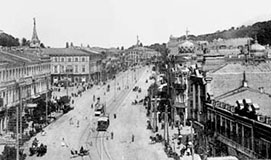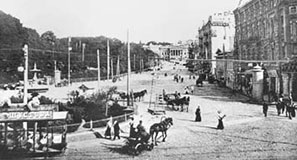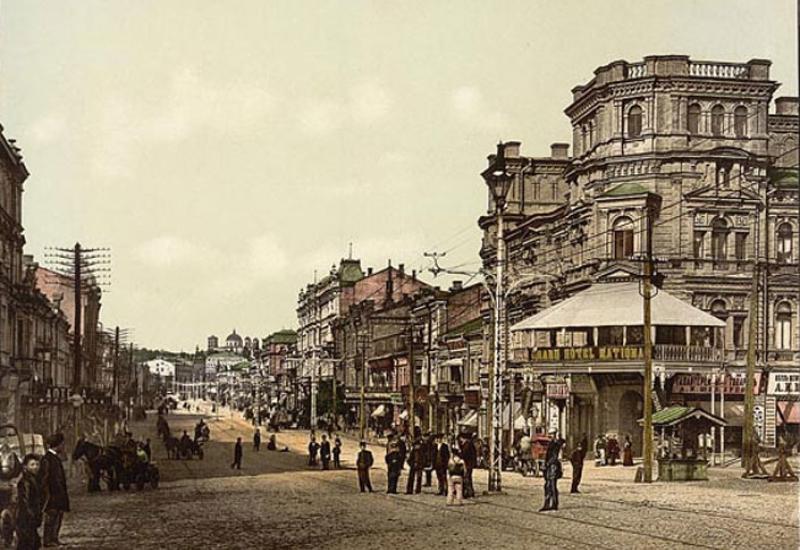Serene recent days - a good time for a walk in the fresh air. And for those who come to study in the KPI from other cities - the opportunity to begin acquaintance with Kyiv, with its historic sites. From where to begin? - Of course, from Khreshchatyk! After all, this is a historical place, even from a traditional point of view. Although its age compared to the age of Kyiv can be considered downright childish...
For many centuries on the site of the present main street of the state there was located an overgrown with thickets, and in some places swampy valley. For its excisions and intersections it was called Kreshchataja (ie, its name has nothing to do with the baptism of Rus', as is often supposed). In the middle of this valley in the direction of the current Bessarabki there was a brook, which in the spring and after heavy rain turned into an angry stream, dangerous enough to passers-by, on their way from the Upper Town on the Lypki. However, summer almost dried up stream, and after at the near steep slopes there appeared the first houses, it started to be a nice bath for ducks and pigs of their inhabitants.
The first stone building dates back only to 1797. It was a large stone house with two wings, which was built by the nobleman Onufry Golovin. In 1849 there was placed the city post office, which, although rebuilt, but since then the place has not changed, only the name. Now here there stands the Kyiv Post Office.

But the real development of this area began after 1830.
The first impetus for the development of Khreschatyk was given by Nicholay I ...
In 1830, Tsar Nicholas I signed a plan to build a new Pechersk fortress in Kyiv. The following year it was started the mass eviction of residents of streets that fall into the area of building and construction of a wide esplanade, which has been built around it. Deportees received from the authorities some compensation for the broken homes, and could choose a place to build on uninhabited areas. Most of the families settled on the banks of the desert then Lybed. But some of the most visionary and enterprising, started buying up the soil in the valley, where it crosses not only gullies and tracts, but also routes connecting Upper Town, Lypki, Pechersk and Podil. Kyiv just entered a period of rapid development, and there were many signs in favor of what Khreschatytska Valley could soon become the main artery of the city. And so it happened. Since the mid 30-ies of the XIX century Khreschatyk began to turn into the main shopping street of the city. Over two decades later, it is already considered a "street from thousands of stores." But for quite a long period, it consisted predominantly of one or two floors houses .
The reason for growing was a fever
This is not about human disease, but about the period, which in the history of the capital was called "construction fever". Actually Kyiv has experienced several of its "attacks", the first of which took place in the seventies of the XIX century. Then Khreschatyk was decorated with three- and four-floor homes, new, in the European spirit shops and granite paving stones. 1876 in Khreschatytska Square (now Independence Square) it was appeared and topped with a tall spire with a figure of the patron saint of the city of St. Michael the Archangel, the building of City Council. Almost in front of it, on the corner of Khreshchatyk and Instytutska street the City Exchange opened its doors. There were began to work around the offices of Kyiv merchants and offices of major banks.
Luxury hotels Kyiv tried to attract guests with the prime location and unprecedented hitherto in Kyiv luxury. Numerous passers were hospitably invited by restaurants and pastry, which is particularly renowned Khreschatyk. Kyiv "Sweet Kings" were considered Balabukha Simon and his heirs, in retail stores they sell well known far beyond the Russian Empire "Kyiv dry jam" (the secrets of their production now, unfortunately, lost). And the only place where everyone could try just imported from the South yogurt, has long been the confectionery Semadeni. It is not surprising, therefore, that since the middle of the XIX century Khreschatyk became favorite and, besides, the most prestigious place for walks Kyiv. If we add that in 1872 in the evening Khreschatyk first was illuminated by gas, and then the electric lights, there is no need to prove what it has attracted many. But then, as now, people lived.

Not only on sweets ...
The cultural life of the city was concentrated on Khreshchatyk. The first permanent theater already appeared here in 1805 – it was constructed with wooden logs in the estate of his wife by Kyiv city architect Andrew Melensky. It was located approximately where today it stands the Ukrainian House, and lasted until 1851. However, there were plenty of theaters in Kyiv without it. By the end of the XIX century on Khreschatyk the eight theaters constantly gave performances. Soon they were joined by illusions, one of which - theater Shantser cinematography, was considered one of the best in Europe.
Loved the people of Kyiv as "pharmacy for the soul," which was opened on Khreschatyk by retired captain P.Dolzhikov. This "Cabinet for reading" was a kind of library, where you can not only borrow books on loan, but also read a newspaper lying on a specially arranged sofas, smoking, buy and again to take on the sale of the book. Only in 1866 in the premises of the Noble Assembly (where now stands the house of Trade Unions) it was opened a public library with a modern service system.
Khreschatyk, how it is remembered by our grandmothers
Twentieth century changed the face of Khreshchatyk. However, this was happened not at once. Throughout the pre-war period, the Soviet government used what was inherited from the previous one. Only the names of shops and offices have changed. It became fashionable not very clear today abbreviations. Even Khreschatyk was temporarily renamed: from 1923 to 1937, it was named the street of Vorovskyy. In the premises of former City Council, which, instead of on the spire shape patron saint of Kyiv St. Michael the Archangel it was appeared a star, it was housed District Committee and City Committee of the CP (b) U, in the Exchange - City Council, in Merchant Club - Palace of Pioneers. Of new buildings that have appeared on Khreschatyk in those days, it is worth noting the building of the central department store, which was not only a landmark of his era, but of late constructivism. However, most of the houses the main street of the capital of Ukraine to the present time have not been preserved. And they were destroyed for one week only.
Destruction and restoration
September 19, 1941, the Germans occupied Kyiv. And on September 24 in the afternoon there was a powerful explosion in the store room "Children's World" on the corner of Khreshchatyk and Prorizna where people on the orders of the occupation authorities, gave their radios. The detonation caused the operation of other explosive devices that the Soviet troops have left during their retreat. There was a grand fire. The fire continued until 2 October. Old Khreschatyk was virtually destroyed. Today it is recognized that some strategic value, this action did not have.
After the liberation of Kyiv it was declared the All-Union contest on restoration of Khreschatyk. It was attended by leading architects of Kyiv, Kharkiv, Moscow and Leningrad. The resulting proposals developed and implemented the team of authors, headed by the then chief architect of Kyiv Anatoly Dobrovolsky. Since then, several modifications (or rather, distortion) suffered a former Khreschatytska area, which is now called Independence Square, and little has changed its face Bessarabska square. Since the last century there survived only a few single houses, where various institutions are now located, and the quarter with an even hand from Khreshchatyr streets of Bohdan Khmelnytsky to the boulevard Shevchenko ...

